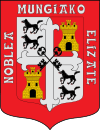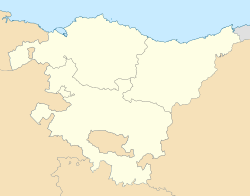Mungia facts for kids
Quick facts for kids
Mungia
|
|||
|---|---|---|---|
| Munguía | |||

Mungia Town Office
|
|||
|
|||
| Country | |||
| Autonomous community | |||
| Province | Biscay | ||
| Comarca | Mungialdea | ||
| Area | |||
| • Total | 52.12 km2 (20.12 sq mi) | ||
| Elevation | 22 m (72 ft) | ||
| Population
(2018)
|
|||
| • Total | 17,554 | ||
| • Density | 336.80/km2 (872.31/sq mi) | ||
| Demonym(s) | mungiarra | ||
| Time zone | UTC+1 (CET) | ||
| • Summer (DST) | UTC+2 (CEST) | ||
| Postal code |
48100
|
||
Mungia (called Munguía in Spanish) is a town and municipality in northern Spain. It is located in the province of Biscay, which is part of the Basque Country. In 2019, about 17,691 people lived there.
Contents
Geography of Mungia
Mungia is located 20 meters (about 65 feet) above sea level. The area has many open spaces and gentle hills. Some of these hills include Gondramendi (217 m), Tallu (342 m), and Berreaga (366 m).
Nearby, you can find larger mountains like Sollube (684 m) and Jata (592 m). These mountains surround the valley of the Butroi river. The Butroi river starts at Bizkargi mountain (536 m) and flows into the sea at the Plentzia estuary.
Many small streams and underground springs flow through Mungia. These include the Atxuri, Trobika, Lauromendi, Atebarri, and Mantzorriko Erreka. They all flow into the Butroi river. These waters also supply the many fountains built in the town. In the past, these waters helped power more than 20 mills, and some of them are still standing today.
History of Mungia
Even though people lived in the Mungia area in prehistoric times, the first written record is from 1051. In that year, an abbot from Mungia confirmed a gift from the Lord of Biscay to a monastery.
The name Mungia comes from the Basque words Mune - Ganean. This means "at the edge of the Butroi river," which describes its location. At first, Mungia was a small village with people living far apart. The church was the main gathering place.
However, Mungia started to become more important. This was because of the abbot and its location. It was a key pass between the inland areas and the coast, especially to Bermeo, which was a busy export harbor. Important noble families built their tower houses in the areas around the village. Their wealth came from owning land.
Challenges and Conflicts
By the late 1200s, there was a crisis in farming and raising animals. This made noble families struggle financially. To get more money, they often used violence. They fought each other, claiming to be "more worthy." Their fights harmed the local farmers, who lost their belongings or were forced to join the fights.
In Mungia, two main groups were fighting: the Billela family (part of the Ganboar group) and the Butroi family (who led the Oinaz group). Their tower houses were close, so fights were common.
Founding the Borough
Because of these conflicts, some villagers asked the Lord of Biscay, Infante Juan, to make Mungia a "borough." A borough was a special town that could build walls and defend itself from attacks.
So, on August 1, 1376, Mungia officially became a borough. It was created in the center of an anteiglesia (a type of village or district unique to the Basque provinces) of the same name. Both the borough and the anteiglesia were part of a larger area called the merindad of Uribe. Each had its own local government. They also had representatives in the Juntas of Gernika, which was the main council for the people of Biscay.
Becoming a borough did not stop all the fighting. There were still many small battles between the noble groups. One important fight was the Battle of Mungia on April 27, 1479. In this battle, the Oinaz and Ganboa groups, who were usually enemies, teamed up to fight against the Earl of Haro.
Life in Early Mungia
Despite the conflicts, life in Mungia was mostly peaceful. The economy was based on farming. There were also small mills along the streams and craft workshops in the borough.
Daily life was rarely disturbed. In 1602, a fire occurred. A larger fire happened on November 9, 1778, burning down fourteen main buildings. After this, people started storing flammable items like straw, wood, and coal outside the town walls. This area was called Atzekaldeta, meaning "the rear part of the town" in Basque.
Uniting Mungia
Over time, the borough of Mungia and the anteiglesia (the surrounding district) worked together more often. They shared services like the school. When they needed to bring water from Gondramendi mountain to the village, they shared the costs. As they cooperated more, they realized it would be better to become one single entity.
This union happened on October 6, 1900, during a special ceremony. The borough and the anteiglesia merged into one Mungia. A fountain in Beko Kale, in front of Arnaga, symbolizes this unity. Its motto is "Biak bat eta biena," which means "Both only one and for both."
Modern Mungia
Life in Mungia was mostly quiet until 1936, with farming and crafts being the main activities. During the Spanish Civil War, Mungia suffered heavy bombings. Also, some buildings were burned by out-of-control groups as they left the town.
The war slowed Mungia's growth. However, in the early 1960s, new industries attracted many workers. People moved to Mungia from nearby towns and other parts of Spain. This led to many new buildings and streets, greatly expanding the town center.
A short economic slowdown in the late 1970s affected Mungia, which had seen a large population increase.
During the long years of Francisco Franco's dictatorship, people resisted through community groups. They often used the Church as a way to support cultural, sports, and educational activities. These activities helped preserve Basque culture and promote democratic ideas.
See also
 In Spanish: Munguía para niños
In Spanish: Munguía para niños





